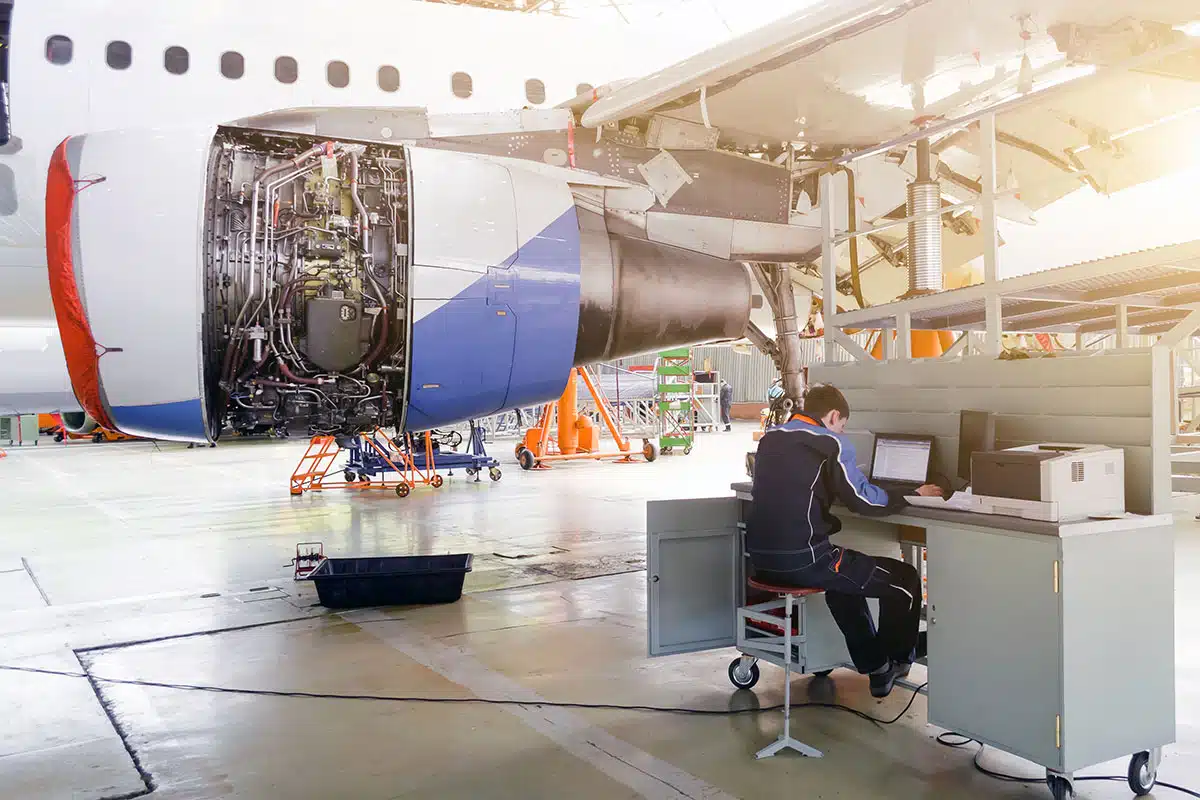When the original Star Trek series launched in 1966, Captain James T. Kirk was pressing buttons on his command chair as Mr. Spock turned dials at his science station. Just 20 years later, when Star Trek: The Next Generation aired, all those buttons and dials had been replaced with computer screens. Today, real planes are undergoing a similar evolution, and this increasing digitalization is just one of several game-changing developments in aerospace manufacturing.
According to McKinsey & Company, original equipment manufacturers (OEMs) in the aerospace industry are facing unprecedented uncertainty and challenges. Some of those include talent shortages, inflation, and supply chain worries. Yet despite these hurdles, inroads are being made. Read on to discover six trends moving the industry forward.
Additive Manufacturing
The aerospace industry is being transformed by additive manufacturing, also known as 3D printing. This new technology offers multiple benefits for aerospace manufacturing.
Rapid Prototyping
Using additive manufacturing, aerospace companies are able to take advantage of rapid prototyping—quickly fabricating a prototype to aid designers in visualizing, redesigning, and developing a part or component before mass production. Rapid prototyping reduces material waste while enhancing design options.
There is a continuous effort to miniaturize electronic components in order to make them both lighter and more compact, without compromising performance. This trend is crucial for aerospace applications since weight is a critical factor.
New Materials
Additive manufacturing increases material options. New additive manufacturing methods, such as fused deposition modeling (FDM) and electron beam melting (EBM), enable the rapid fabrication of complex geometries, making it easier to use novel materials.
Lightweight components
By increasing the range of material options, additive manufacturing makes it easier to create lightweight components, fulfilling a crucial need in the aerospace industry for improved fuel efficiency, which saves money and reduces carbon emissions.
Lower Production Costs
In addition to the above benefits, additive manufacturing increases a manufacturer’s bottom line by reducing the time from design to production, minimizing waste, and streamlining aerospace supply chains.
Smart and Connected Systems
The integration of smart systems is becoming more prevalent in aerospace manufacturing. Smart and connected systems can enhance maintenance procedures and overall operational efficiency. This evolution involves incorporating sensors, Internet of Things (IoT) devices, and data analytics to monitor and optimize the performance of aircraft systems.
Internet of Things
Manufacturers are designing sensors and software that take advantage of the Internet of Things, making aircraft safer and more efficient by allowing aerospace companies to monitor and control systems and equipment in real time. For example, IoT devices can recognize potential safety issues before they become a reality and take proactive steps to remedy them. Another way these devices increase safety is by remotely monitoring hangars, reducing the risk of airplane tampering and improving on-ground security.
Big Data Analytics
Airplanes have long had numerous sensors to collect data in flight—such as speed, altitude, stability, and more. This data not only influences the plane’s operation, it can also trigger calls for maintenance once the aircraft is on the ground. Yet, traditionally, maintenance crews have taken a reactive approach to airplane maintenance. Now, the ability to quickly analyze large amounts of raw data makes it possible to discover even more nuanced patterns and trends, enabling ground crews to engage in predictive maintenance.

The large volume of raw data that can now be analyzed enables more precise monitoring of various parts and systems, so that any needed equipment replacements or upgrades can be made long before a failure occurs. This proactive approach to plane operation and maintenance reduces the time that planes are grounded, saving money and improving aircraft functionality. Of course, this increased connectivity comes with inherent cybersecurity risks to flight data and avionics systems. But companies are addressing these vulnerabilities with advanced encryption protocols and intrusion detection systems specifically tailored for aerospace applications.
Advanced Materials
An aerospace manufacturer faces many challenges unique to the industry: weight constraints for each component, demand for materials that can withstand high stress and temperature variations, and the need to avoid corrosion. For these reasons, engineers are constantly seeking novel materials that can meet these challenges, and they’re finding success with advanced materials like fiber-reinforced polymers and ceramic matrix composites. Compared to traditional metals, these new materials offer a superior strength-to-weight ratio and better corrosion resistance, enabling designers to reduce overall aircraft weight and improve fuel efficiency—all while increasing durability and maintaining structural integrity under stressful conditions.
When manufacturing space vehicles, materials challenges increase. For example, cosmic radiation can significantly influence electronics in space, which makes shielding a priority. Materials must also withstand the extreme cold of space and—on the other hand—the high heat and stress of atmosphere re-entry, while meeting the demand for high vehicle longevity. As with the aviation industry, manufacturers of space vehicles are turning to composite materials for solutions. For example, manufacturers are making electronics resistant to radiation by using field-effect transistors that incorporate carbon nanotubes as channel material, along with an ion gel as gate material.
Miniaturization of Electronics
There is a continuous effort to miniaturize electronic components in order to make them both lighter and more compact, without compromising performance. This trend is crucial for aerospace applications since weight is a critical factor in aerospace manufacturing. Manufacturers have developed miniaturized components for navigation, guidance and communication systems, cockpit displays, propulsion systems, and more.
This miniaturization is made possible by the new generation of high-performance microprocessors, which receive input from various sensors and navigational aids and then use that input to perform complex, real-time calculations to control the aircraft’s subsystems. Miniaturized ICs, for example, are enabling the replacement of traditional analog gauges with digital displays on high-resolution screens. These new display systems, which are collectively referred to as a glass cockpit, allow pilots to easily view real-time data, which in turn enables them to make better decisions.
Miniaturization is also affecting electromechanical systems. Sensors, actuators, and other machines are shrinking, even as they become more sensitive. Due to better sensing capabilities, these systems have higher accuracy—new accelerometers are bringing even greater precision to navigation controls, and temperature sensors are making air conditioning units more efficient. And with fewer moving parts, these systems are also more reliable.

Miniaturized components are introducing improvement across the industry. In aviation, airplanes are more efficient and safer thanks to these devices. In space, these devices are enabling the building of smaller, more affordable satellites and other space vehicles. And, in the military realm, these components are improving situational awareness, weapons systems, and communications.
Sustainability
Making the aerospace industry more sustainable requires a multi-pronged approach.
Electrification
Carmakers aren’t the only manufacturers who recognize the advantages of electrification. The aerospace industry is also taking notice. Emerging airplane designs replace conventional hydraulic, mechanical, and pneumatic systems with electric counterparts. For example, the Boeing 787 has already adopted electrified environmental control and wing anti-icing systems.
Going a step further, planes that are fully electric could provide a sustainable solution for the planet. According to a study by the University of Nottingham, conventional aviation powered by fossil fuels is responsible for 12 percent of the carbon dioxide emissions from all transport services. Electric planes, on the other hand, produce emissions that are near zero.
And carbon emissions aren’t the only pollution eliminated by electrification. Fully electric planes have the potential to significantly reduce noise pollution as well. The longtime concern of living too near an airport could become a worry of the past if electric planes take over. Additionally, with fewer moving parts, electric planes would be subject to less wear and tear, reducing the amount of landfill waste from expired parts.
Sustainable aviation fuel
In 2023, after five days of U.N.-led talks in Dubai, 100 countries agreed that by 2030 aviation fuel should be five percent less carbon intensive. One approach to address this goal is sustainable aviation fuel (SAF), a fuel made from non-petroleum feedstocks. According to the U.S. Department of Energy, this fuel is already being used in 46 different airports, mostly in Europe and the United States.
Improved Electronics
Perhaps the most effective way to make air travel less carbon intensive is to reduce weight and improve efficiency, and here electronics have a big role to play. For example, the miniaturization of components is allowing engineers to build smaller and lighter devices. This is a crucial development, as every ounce on a plane adds up: Did you know that every laptop on a flight costs the airline 33 cents? Furthermore, these new electronic systems also enable more precise navigation and route planning, enabling pilots to fly more efficiently and so reduce fuel waste.
New Training Methods for Aerospace Manufacturing Talent
Mechanics, aerospace engineers, and technicians are crucial to the aerospace industry, and workers for these jobs are in demand. A report from AAR Corporation forecasts that the global aviation market will need 34,500 new mechanics annually, and the U.S. Bureau of Labor Statistics says that the job outlook for aerospace engineers will grow by six percent in a decade (compared to the three percent average across all occupations).
Training all these new workers requires thinking outside the box. This is why some companies are beginning to use immersive technologies like virtual reality (VR) and augmented reality (AR) to enhance aerospace training using life-like scenarios. Likewise, savvy employers are thinking outside the box when it comes to recruiting. Companies that take a broad approach to hiring—for example, pulling from underutilized talent pools such as people with disabilities—have a greater chance of filling essential positions.
Meeting Challenges Through Technology
The aerospace industry is experiencing significant changes. Sustainability challenges, talent shortages, and new consumer demands will make tomorrow’s aerospace landscape look and operate very differently from today’s. Fortunately, solutions ranging from additive manufacturing to augmented reality are available to meet these challenges head on. With innovation, determination, and outside-the-box thinking, the future of the aerospace industry looks bright.